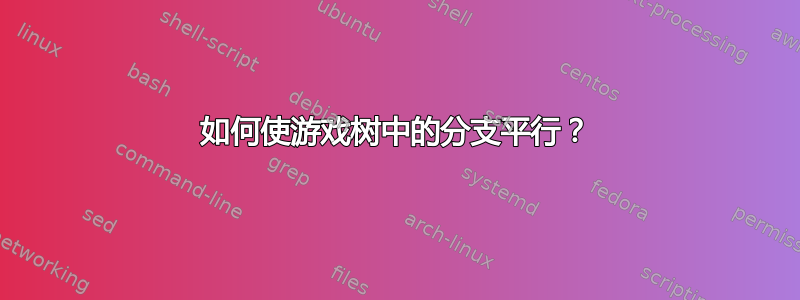
\documentclass[leqno, oneside, 12pt]{book}
\usepackage{amsmath}
\usepackage{istgame}
\usepackage{caption}
\usepackage{makecell}
\begin{document}
\begin{figure}[ht]
\centering
\begin{istgame}[font=\footnotesize]
\xtdistance{30mm}{90mm}
\setxtinfosetstyle{dashed}
\xtShowEndPoints
\istroot[right](0)<above>{0}
\istbA{0.95}[above,sloped]
\istbA{0.05}[above,sloped]
\endist
\xtdistance{30mm}{30mm}
\istroot[right](1)(0-2)<above>{1.1}
\istbA{g_1\quad(\beta)}[above,sloped]
\istbA{f_1\quad(1-\beta)}[above,sloped]{0,0}
\endist
\xtOwner(1){\makecell{$\langle\alpha\rangle$}}[below]
\istroot[right](2)(0-1)<above>{1.1}
\istbA(2){g_1\quad(\beta)}[above,sloped]
\istbA{f_1\quad(1-\beta)}[above,sloped]{0,0}
\endist
\xtOwner(2){\makecell{$\langle1-\alpha\rangle$}}[below]
\istroot[right](3)(1-1)<above>{2.2}
\istbA{g_2\quad(\gamma)}[above,sloped]
\istbA{f_2\quad(1-\gamma)}[above,sloped]{-1,5}
\endist
\xtOwner(3){\makecell{$\langle1\rangle$}}[below]
\istroot[right](4)(3-1)<above>{1.3}
\istbA{g_3\quad(\epsilon)}[above,sloped]
\istbA{f_3\quad(1-\epsilon)}[above,sloped]{4,4}
\endist
\xtOwner(4){\makecell{$\langle\delta\rangle$}}[below]
\istroot[right](5)(2-1)<above>{1.3}
\istbA(2){g_3\quad(\epsilon)}[above,sloped]{8,8}
\istbA{f_3\quad(1-\epsilon)}[above,sloped]{4,4}
\endist
\xtOwner(5){\makecell{$\langle1-\delta\rangle$}}[below]
\istroot[right](6)(4-1)<above>{2.4}
\istbA{g_4\quad(\zeta)}[above,sloped]{8,8}
\istbA{f_4\quad(1-\zeta)}[above,sloped]{3,9}
\endist
\xtOwner(6){\makecell{$\langle1\rangle$}}[below]
\xtInfosetO(1)(2)(1.2cm)
\xtInfosetO(3)(3)(1.2cm)
\xtInfosetO(4)(5)(1.2cm)
\xtInfosetO(6)(6)(1.2cm)
\end{istgame}
\caption{}
\end{figure}
\end{document}
我想让每个向上的分支彼此平行,每个向下的分支也彼此平行。(如您所见,现在向下的线并不平行。)同时,两个 1.1 节点需要对齐,两个 1.3 节点也需要对齐。我该怎么做?非常感谢任何帮助!
答案1
我对这个包不是很熟悉,但是我查看了文档,似乎没有办法指定替代(或弧)的角度\istbA;只有像你所做的那样,一种方法来指定子项的扩展。
\documentclass[tikz,margin=10pt]{standalone}
\usepackage{istgame}
\usepackage{makecell}
\begin{document}
\begin{istgame}
\xtdistance{30mm}{90mm}
\setxtinfosetstyle{dashed}
\xtShowEndPoints
\setistgrowdirection'{east}
\istroot(0)<above>{0}
\istbA{to:0-1}[above,sloped]
\istbA{to:0-2}[above,sloped]
\endist
\xtdistance{30mm}{30mm}
\istroot(1)(0-1)<above>{1}
\istbA{to:1-1}[above,sloped]{end}
\istbA{to:1-2}[above,sloped]
\endist
\xtOwner(1){\makecell{1label}}[below]
\istroot(2)(0-2)<above>{2}
\istbA{to:2-1}[above,sloped]{end}
\istbA(2){to:2-2}[above,sloped]
\endist
\xtOwner(2){\makecell{2label}}[below]
\istroot(3)(1-2)<above>{3}
\istbA{to:3-1}[above,sloped]{end}
\istbA{to:3-2}[above,sloped]
\endist
\xtOwner(3){\makecell{3label}}[below]
\istroot(4)(3-2)<above>{4}
\istbA{to:4-1}[above,sloped]{end}
\istbA{to:4-2}[above,sloped]
\endist
\xtOwner(4){\makecell{4label}}[below]
\istroot(5)(2-2)<above>{5}
\istbA{to:5-1}[above,sloped]{end}
\istbA(2){to:5-2}[above,sloped]{end}
\endist
\xtOwner(5){\makecell{5label}}[below]
\istroot(6)(4-2)<above>{6}
\istbA{to:6-1}[above,sloped]{end}
\istbA{to:6-2}[above,sloped]{end}
\endist
\xtOwner(6){\makecell{6label}}[below]
\xtInfosetO(1)(2)(1.2cm)
\xtInfosetO(3)(3)(1.2cm)
\xtInfosetO(4)(5)(1.2cm)
\xtInfosetO(6)(6)(1.2cm)
\end{istgame}
\end{document}
有一种方法可以添加“缺失”子元素,简称为\istb<missing>或\istbm。不幸的是,很难说出 的角度是如何\istbA(<level>)计算的,因此即使使用这种简化的模型,尝试通过添加这些缺失的子元素来对齐底行也显得太过繁琐。
\documentclass[tikz,margin=10pt]{standalone}
\usepackage{istgame}
\usepackage{makecell}
\begin{document}
\begin{istgame}
\xtdistance{30mm}{60mm}
\setxtinfosetstyle{dashed}
\xtShowEndPoints
\setistgrowdirection'{east}
\istroot(0)<above>{0}
\istbA{to:0-1}[above,sloped]
\istbA{to:0-2}[above,sloped]
\endist
\xtdistance{30mm}{30mm}
\istroot(1)(0-1)<above>{1}
\istbA{to:1-1}[above,sloped]{end}
\istbA{to:1-2}[above,sloped]
\istbm
\endist
\xtOwner(1){\makecell{1label}}[below]
\istroot(2)(0-2)<above>{2}
\istbA{to:2-1}[above,sloped]{end}
\istbA(2){to:2-2}[above,sloped]
\istbm
\endist
\xtOwner(2){\makecell{2label}}[below]
\istroot(3)(1-2)<above>{3}
\istbA{to:3-1}[above,sloped]{end}
\istbA{to:3-2}[above,sloped]
\istbm
\endist
\xtOwner(3){\makecell{3label}}[below]
\istroot(4)(3-2)<above>{4}
\istbA{to:4-1}[above,sloped]{end}
\istbA{to:4-2}[above,sloped]
\istbm
\endist
\xtOwner(4){\makecell{4label}}[below]
\istroot(5)(2-2)<above>{5}
\istbA{to:5-1}[above,sloped]{end}
\istbA(2){to:5-2}[above,sloped]{end}
\istbm
\endist
\xtOwner(5){\makecell{5label}}[below]
\istroot(6)(4-2)<above>{6}
\istbA{to:6-1}[above,sloped]{end}
\istbA{to:6-2}[above,sloped]{end}
\istbm
\endist
\xtOwner(6){\makecell{6label}}[below]
\xtInfosetO(1)(2)(1.2cm)
\xtInfosetO(3)(3)(1.2cm)
\xtInfosetO(4)(5)(1.2cm)
\xtInfosetO(6)(6)(1.2cm)
\end{istgame}
\end{document}
同样,这不是理想的选择,但如果您的目标是并行,那么这样做就可以了。我建议添加[scale=1.2]或类似于的\begin{istgame}扩展,但这是个人喜好。在下面的 MWE 中,您会注意到我删除了标签[right]并添加了标签\setistgrowdirection'{east},这会使节点在代码中以合理的方式从上到下排列,至少在我看来是这样。
希望这能有点帮助!
梅威瑟:
\documentclass[tikz,margin=10pt]{standalone}
\usepackage{istgame}
\usepackage{makecell}
\begin{document}
\begin{istgame}
\xtdistance{30mm}{60mm}
\setxtinfosetstyle{dashed}
\xtShowEndPoints
\setistgrowdirection'{east}
\istroot(0)<above>{0}
\istbA{0.05}[above,sloped]
\istbA{0.95}[above,sloped]
\endist
\xtdistance{30mm}{30mm}
\istroot(1)(0-1)<above>{1.1}
\istbA{f_1\quad(1-\beta)}[above,sloped]{0,0}
\istbA{g_1\quad(\beta)}[above,sloped]
\istbm
\endist
\xtOwner(1){\makecell{$\langle\alpha\rangle$}}[below]
\istroot(2)(0-2)<above>{1.1}
\istbA{f_1\quad(1-\beta)}[above,sloped]{0,0}
\istbA(2){g_1\quad(\beta)}[above,sloped]
\istbm
\endist
\xtOwner(2){\makecell{$\langle1-\alpha\rangle$}}[below]
\istroot(3)(1-2)<above>{2.2}
\istbA{f_2\quad(1-\gamma)}[above,sloped]{-1,5}
\istbA{g_2\quad(\gamma)}[above,sloped]
\istbm
\endist
\xtOwner(3){\makecell{$\langle1\rangle$}}[below]
\istroot(4)(3-2)<above>{1.3}
\istbA{f_3\quad(1-\epsilon)}[above,sloped]{4,4}
\istbA{g_3\quad(\epsilon)}[above,sloped]
\istbm
\endist
\xtOwner(4){\makecell{$\langle\delta\rangle$}}[below]
\istroot(5)(2-2)<above>{1.3}
\istbA{f_3\quad(1-\epsilon)}[above,sloped]{4,4}
\istbA(2){g_3\quad(\epsilon)}[above,sloped]{8,8}
\istbm
\endist
\xtOwner(5){\makecell{$\langle1-\delta\rangle$}}[below]
\istroot(6)(4-2)<above>{2.4}
\istbA{f_4\quad(1-\zeta)}[above,sloped]{3,9}
\istbA{g_4\quad(\zeta)}[above,sloped]{8,8}
\istbm
\endist
\xtOwner(6){\makecell{$\langle1\rangle$}}[below]
\xtInfosetO(1)(2)(1.2cm)
\xtInfosetO(3)(3)(1.2cm)
\xtInfosetO(4)(5)(1.2cm)
\xtInfosetO(6)(6)(1.2cm)
\end{istgame}
\end{document}
答案2
我想使用\istb而不是使用\istbA。
你可能想替换\istbA(2)为
\istbA(2)<grow=-27,level distance=67mm>
或者简单地使用
\istb<grow=-27,level distance=67mm>。
这种改变将产生您想要的(近似)结果。
\documentclass[leqno, oneside, 12pt]{book}
\usepackage{amsmath}
\usepackage{istgame}
\usepackage{caption}
\usepackage{makecell}
\begin{document}
\begin{figure}[ht]
\centering
\begin{istgame}[font=\footnotesize]
%%% some calculation:
\pgfmathparse{90-atan(30/15)}
\node(0,0)[draw,yshift=10mm]{\pgfmathresult};
\pgfmathparse{sqrt(30^2+15^2)}
\node(0,0)[draw,yshift=15mm]{\pgfmathresult};
%%% tree direction
\setistgrowdirection{east} %%% instead of using [right] in \istroot
%\setistgrowdirection'{east} %%% (swap version) looks more convenient
%%% \istb (instead of \istbA)
\xtdistance{30mm}{90mm}
\setxtinfosetstyle{dashed}
\xtShowEndPoints
\istroot(0)<above>{0}
\istb{0.95}[above,sloped]
\istb{0.05}[above,sloped]
\endist
\xtdistance{30mm}{30mm}
\istroot(1)(0-2)<above>{1.1}
\istb{g_1\quad(\beta)}[above,sloped]
\istb{f_1\quad(1-\beta)}[above,sloped]{0,0}
\endist
\xtOwner(1){\makecell{$\langle\alpha\rangle$}}[below]
\istroot(2)(0-1)<above>{1.1}
\istb<grow=-27,level distance=67mm>[blue,thick] %%% CHANGED
{g_1\quad(\beta)}[above,sloped]
\istb{f_1\quad(1-\beta)}[above,sloped]{0,0}
\endist
\xtOwner(2){\makecell{$\langle1-\alpha\rangle$}}[below]
\istroot(3)(1-1)<above>{2.2}
\istb{g_2\quad(\gamma)}[above,sloped]
\istb{f_2\quad(1-\gamma)}[above,sloped]{-1,5}
\endist
\xtOwner(3){\makecell{$\langle1\rangle$}}[below]
\istroot(4)(3-1)<above>{1.3}
\istb{g_3\quad(\epsilon)}[above,sloped]
\istb{f_3\quad(1-\epsilon)}[above,sloped]{4,4}
\endist
\xtOwner(4){\makecell{$\langle\delta\rangle$}}[below]
\istroot(5)(2-1)<above>{1.3}
\istb<grow=-27,level distance=67mm>[blue,thick] %%% CHANGED
{g_3\quad(\epsilon)}[above,sloped]{8,8}
\istb{f_3\quad(1-\epsilon)}[above,sloped]{4,4}
\endist
\xtOwner(5){\makecell{$\langle1-\delta\rangle$}}[below]
\istroot(6)(4-1)<above>{2.4}
\istb{g_4\quad(\zeta)}[above,sloped]{8,8}
\istb{f_4\quad(1-\zeta)}[above,sloped]{3,9}
\endist
\xtOwner(6){\makecell{$\langle1\rangle$}}[below]
\xtInfosetO(1)(2)(1.2cm)
\xtInfosetO(3)(3)(1.2cm)
\xtInfosetO(4)(5)(1.2cm)
\xtInfosetO(6)(6)(1.2cm)
\end{istgame}
\caption{}
\end{figure}
\end{document}







